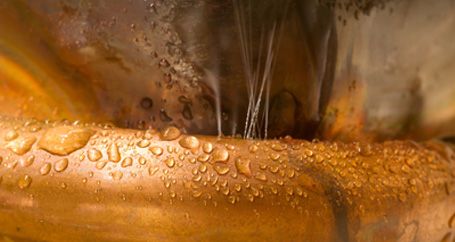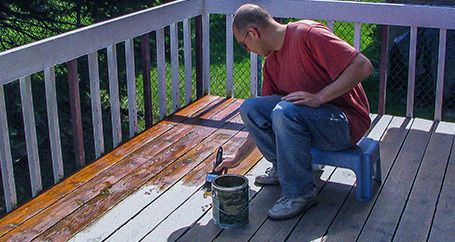Todd Vandermeulen loved the pine tree shading his family’s split-level house in Seattle, even though it tended to drop small limbs as fall winds picked up. Then winter closed in. “We were hunkered inside to watch the beautiful snow, and we hear this thud,” Vandermeulen says. A 100-pound branch hit the roof and damaged a gutter before crashing to the ground.
The damage was minor — but enough to teach Vandermeulen a good lesson about home maintenance: it’s better to take care of things before changing weather causes real problems. Fall maintenance — things like inspecting the roof and foundation, insulating windows and sealing anything that might leak — will “save people money by catching issues proactively before something becomes a huge repair,” says Josh Stech, who knows maintenance inside out as the CEO of a California-based company that provides a marketplace for homes being sold in as-is condition.
Questions about coverage?
Get personal service from a Farmers® agent, and review homeowners insurance policy coverage anytime.
Outdoor Cleanup

Roof and Exterior
A visual inspection of a home, from the chimney to the foundation, can help reveal vulnerabilities that lead to trouble when wind, freezing temperatures, snow or winter rains rule, says Chuck Roydhouse, a retired professional firefighter and president of the Chimney Safety Institute of America.
He suggests using a drone or binoculars to look for debris, which will need to be cleaned up, and missing or loose shingles, which should be fixed or replaced before they lead to leaks. Overhanging tree limbs should be trimmed, so they can’t come down, potentially puncturing the roof and causing leaks, water damage and mold.

Roof and Exterior
A visual inspection of a home, from the chimney to the foundation, can help reveal vulnerabilities that lead to trouble when wind, freezing temperatures, snow or winter rains rule, says Chuck Roydhouse, a retired professional firefighter and president of the Chimney Safety Institute of America.
He suggests using a drone or binoculars to look for debris, which will need to be cleaned up, and missing or loose shingles, which should be fixed or replaced before they lead to leaks. Overhanging tree limbs should be trimmed, so they can’t come down, potentially puncturing the roof and causing leaks, water damage and mold.

Fall and winter are also prime time for rodents to come indoors for warmth, says Chase Hazelwood, third-generation owner of a North Carolina pest-control company. He recommends sealing up even the smallest holes and gaps in the foundation, attic or crawl spaces. Firewood, he adds, should not be stored against the house because it can cause a beetle and/or termite infestation.
Gutters
To keep gutters running well, experts like Jesse Silkoff, co-founder and president of an online service that matches U.S. homeowners with local roofers, suggest checking them monthly for twigs, leaves and other debris. Plan bigger cleanings — including running water down all the downspouts — both before autumn leaves fall and again after trees are bare, to be sure fall and winter rain and snowmelt can flow down and away from the house — instead of into the walls, which can cause rot and mold and invite insects.
Clogged gutters — along with poorly ventilated roofs and under-insulated attics — are also a common culprit for damaging ice dams. Ice dams form when rooftop snow melts and refreezes, building up thick layers of ice that eventually push into joins and cracks in the roof and cause leaks.

Find out what homeowners can do to help prevent ice dams from forming. Read more
Landscaping
Some experts note that grass will fare better if it is fertilized after the hottest days of summer are over, when the fertilizer can encourage blade growth and strengthen the root system for winter. Rake off all leaves and give the lawn a final mowing once it stops growing. (A local garden center can guide you on fertilizer formulas suited to your climate and lawn.)
Fall is also a good time to cut dead branches off trees, according to the Arbor Day Foundation, but pruning for shape and size should wait for late winter or early spring.

Landscaping
Some experts note that grass will fare better if it is fertilized after the hottest days of summer are over, when the fertilizer can encourage blade growth and strengthen the root system for winter. Rake off all leaves and give the lawn a final mowing once it stops growing. (A local garden center can guide you on fertilizer formulas suited to your climate and lawn.)
Fall is also a good time to cut dead branches off trees, according to the Arbor Day Foundation, but pruning for shape and size should wait for late winter or early spring.

Outdoor pipes and water sources
Frozen water can burst pipes and hoses. Garden hoses should be detached and drained. Outdoor faucets can be left on to drain after water to the outside is shut off, says Mark Dawson, chief operating officer of a chain plumbing business. He notes that irrigation systems should be blown out using an air compressor or risk freezing — and having to replace irrigation lines come spring.
Deck
Sealing a deck can help prevent damage from rain and snow. That means repairing or replacing loose or cracked boards, washing off dirt and mildew, vacuuming and applying a wood sealer. If a path through the snow on a deck is needed, consider using a shovel with a plastic or rubber blade to avoid damaging the wood.
Outdoor furniture
Umbrellas and furniture that could be blown over can be brought inside or stacked and weighted down, to reduce the risk of damage. Grills should be moved indoors and outdoor appliances such as mini fridges should be unplugged.
Tools
Brianne Deerwester of the nonprofit Electrical Safety Foundation International says that lawn mowers, leaf blowers and other yard tools should be brought indoors and drained of fuel.
Cold-weather tools like snow blowers should be readied for winter by inspecting them for damaged spark plugs and belts, she adds.
Pool
Where freezing is a risk, pools need winterizing, a multistep process many leave to pool maintenance companies. Winterizing means cleaning the pool, balancing the pH, adding chemicals to keep the water clean and algae free, then backwashing the filter and, in some kinds of pools, draining the water below the bottom of the skimmer. Water lines can also be blown out using an air compressor to prevent freezing. Depending on your location and other factors, a pool maintenance company may charge roughly $250 to $350 for a full winterization service.
Indoor Maintenance

Doors, windows and other drafty spots
To keep houses warm without sending heating bills through the roof, and to save energy, the federal Environmental Protection Agency recommends sealing spots where cold air can sneak in, focusing on the attic, foundation and around windows and doors. Caulking, weather stripping and door draft guards can be inexpensive DIY fixes.
For single-pane windows, adding plastic film or storm windows reduces heat escape and cold penetration. Replacing them with insulating double-paned windows is a more expensive option.
Attic
Insulating the attic and sealing all gaps and cracks around recessed lighting, plumbing, chimneys and other breaks in the attic floor — any place where warm air can escape and cold air can sneak in — is the top recommendation of the nonprofit Center for Energy and Environment in Minnesota. It pays for itself quickly in reduced heating costs, says the center’s Ashley Robertson.
Insulating the attic not only keeps warmth in the living space below but also helps prevent ice dams on the roof. The EPA recommends an R-value of 38, or about 10 to 14 inches of insulation, with enough that the insulation rises above the floor joists. Attic vents should be clear of dirt, twigs or insulation.
Heating
A good time for an annual HVAC system check — to look for wear in parts like the blower motor — is before having to turn on the heat, according to the International Association of Certified Home Inspectors.
Robertson recommends checking local utilities to see if they offer free energy audits or rebates for energy-efficient appliances, including furnaces. She also recommends changing furnace filters every 60 to 90 days.
Thermostat
Using a programmable thermostat, or adjusting a manual thermostat before leaving the house or going to bed, can cut the heating bill by as much as 30 percent while still keeping a home cozy, according to the EPA. Consumers can find Wi-Fi-enabled thermostats, which can be managed remotely via smart phone, for about $100 to $300.
“Our recommendation is one degree back per hour that you’re gone from the home, for up to eight hours,” says Robertson.

Fireplaces, wood-burning stoves and chimneys
Any fuel-burning device — a wood stove, fireplace, pellet stove or gas fireplace — should be checked and cleaned of built-up soot or creosote, which can cause fires or trap carbon monoxide in the house, says Roydhouse. He says cracks in brickwork or masonry should be patched. Igniters, blowers and other electrical components on a wood stove or gas fireplace need checking and adjustment.
The Chimney Safety Institute of America offers chimney sweep credentials nationally.
Basement
Along with cleaning gutters, making sure a basement is ready for winter means checking the foundation for cracks, which freezing water can widen and make for a very expensive repair, says Roydhouse. Sump pumps need to be checked for wear.
Miscellaneous
Fall is a good time to test smoke and carbon monoxide detectors and replace batteries, says the National Fire Protection Association.
Update first-aid kits for home and vehicles, replace flashlight batteries and check that emergency go-bags are stocked with fresh water, food, medicines and weather-resistant supplies to last at least 72 hours.
The big payoff is savings on repairs — and peace of mind
Fall maintenance “is not something that people get excited about putting money toward,” admits Robertson at the Center for Energy and Environment. But, she adds, all the homeowners she works with are happy with how much they’re saving and how cozy their homes are.
Written by
The information contained in this page is provided for general informational purposes only. The information is provided by Farmers® and while we endeavor to keep the information up to date and correct, we make no representations or warranties of any kind, express or implied, about the completeness, accuracy, reliability, suitability or availability with respect to this article or the information, products, services or related graphics, if any, contained in this article for any purpose. The information is not meant as professional or expert advice, and any reliance you place on such information is therefore strictly at your own risk.
Related articles



